Dear Varalaaru.com Readers, We the authors of this article Dr.Gokul Seshadri, Dr.S.Sumitha & S.Seetharaman have presented this article of the Architecture of the RaṅgaVimāna at Sri Raṅganāthaswāmi Temple, Srīraṅgam in TNHC conference held in Karaikudi this year. We are very happy to share this with you all! Thanks. Conference: Tamil Nadu History Congress Category: Art and Architecture Abstract The Raṅganāthaswāmi temple at Srīraṅgam, TiruchirāppaḷḷiDistrict, Tamil Naduis one of the most celebrated vaiṣṇaviteshrines in Tamiḷ Nadu, whose antiquity can be traced back to pre-pallava period. Nucleus of this massive temple complex, constituting a number of shrines and sub shrines enclosed by seven āvaraṇas, is the vimāna of the central shrine dedicated to Lord Sri Raṅganāthaswāmi. Popularly known as the raṅgavimāna, this structure is steeped in myths and legends – as exposed by various references inkōilolugu, srīraṅgamahatmiyam and other purāṇicliteratures. This article is an exposition of the architectural aspects of this vimana proper and some proposals on periodization of this structure. Introduction The temple of SrīRaṅganāthaswāmi located at Srīraṅgam(10.8560° N, 78.6966° E),an island on the banks of river Kāvēri in Tiruchirāppaḷḷidistrict, Tamiḷ Nādu, South India – is one of the most revered Vaiṣṇavite shrines in the country. Filled with various religious festivities, ceremonies and rituals throughout the year, this temple attracts a large number of pilgrims and tourists from India and abroad. Early references to this temple can be traced back to Silappadikāram, a post Saṅgam period (200-500 CE) Tamiḷ composition, in which poet Iḷangōvadiaḷ alludes to “the project land (of Srīraṅgam), formed by the large river Kāvēri - replete with big waves, wherein the one, whose chest is the residence of goddess lakṣhmi (viṣṇu), is lying down in a thousand-headed snake bed (ādiśēsha) - just like blue clouds resting over a gold mound, worshipped by all”(Silappadikāram. Kādukānkādhai. Nos. 35-40). Thus, the temple seems to have come into existence on or before 6th Century CE. In the Tamiḷ literatures of the Bhakti cult, viz. the Nālāyaira Divya Prabandam, the glory of Srīraṅgam and its temple find numerous references. Eleven out of twelve Āḷwars elaborately sing in praise of the temple, surroundings, deity and rituals at Srīraṅgam in 247 devotional couplets, attesting its growing popularity during Pallava period. The temple continued to receive patronage from the Chōḷas, second empire Pāṇḍyas, Hoysalās and Vijayanagar kings – as gleaned by various architectural and epigraphic remnants. Temple Complex Nucleus of this massive temple complex, which spans a total area of 631, 000 sq. m, is the central shrine of Raṅganāthaswāmi (a form of Viṣṇu reclining in a coiled serpent bed, the ādiśēsha). This structure was augmented with many other shrines, sub shrines, maṇḍapas, prākāras and gōpuras at different points of time. Quarters of various temple servants, maṭās, pāṭasālās and other structures located around the temple, came to be enclosed by huge rampant wall enclosures - resulting in a seven concentric āvaraṇas around the main shrine. Today, the temple distinguishes itself as being the largest Hindu temple complex in India. THE RANGAVIMANA The main shrine of Raṅganāthaswāmitemple includes a vimana (known as the Raṅgavimāna), an abutting ardhamaṇḍapa, a mukhamaṇḍapa (called Gāyatrimaṇḍapa), a vestibule (idaināḷigai) with wide steps on both side and a mahāmaṇḍapa– all raised over a upapīṭha. A thick parapetwall rising above the upapīṭha, encircles the vimāna, ardhamaṇḍapa and mukhamaṇḍapa structures, effectively hiding vimana āditaḷa from outside view. The space between parapet wall and central vimana serves as the inner prākāra (called Dharmavarmantiruchurru). The south facing Rangavimāna is an ekatala tala vēsara vimana raised over a multisided polygonal platform.The overall length and breadth of the polygonal platform is 23' by 23'. Balipīṭhas are placed at the four corners of the platform. The vesara vimana is 69' (circumference at pattika level) has an adhishthana, bhitti, prastara, griva, sikhara and stupi. 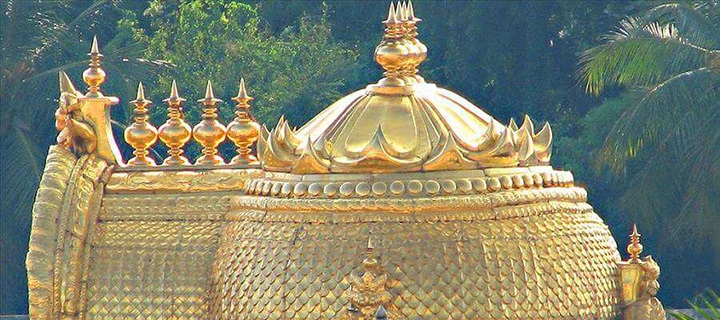
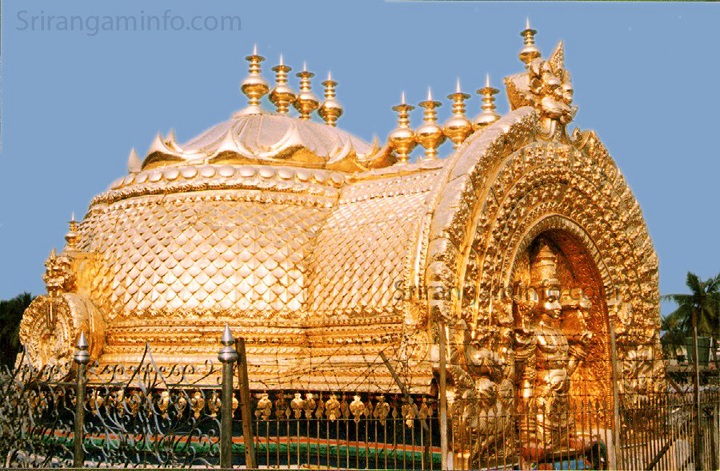
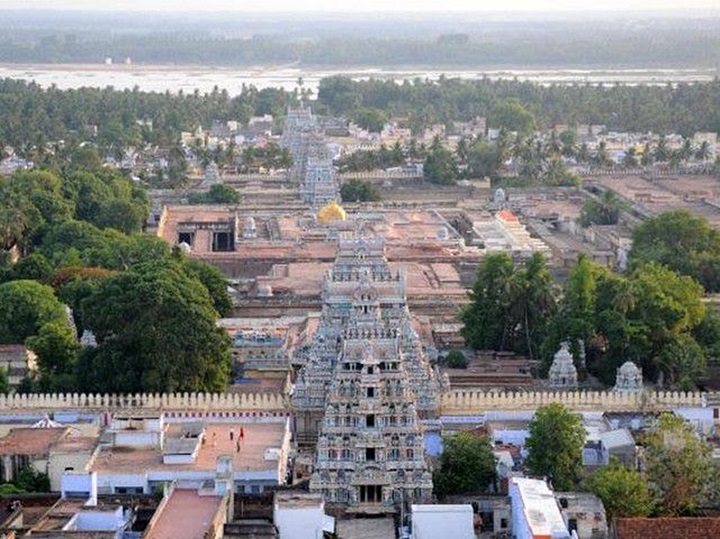
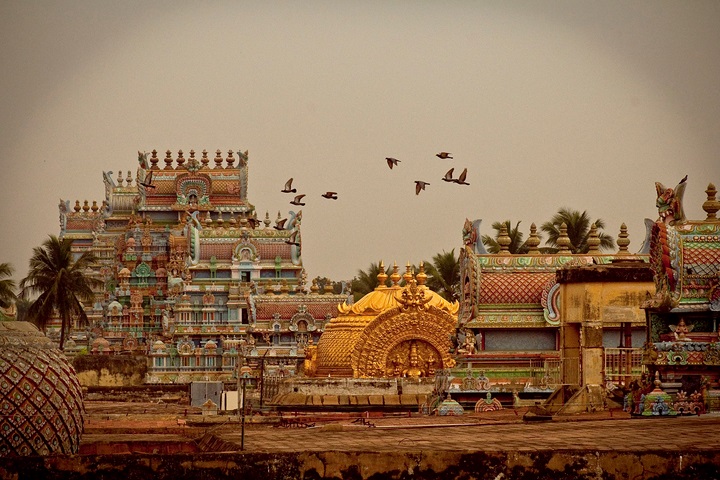
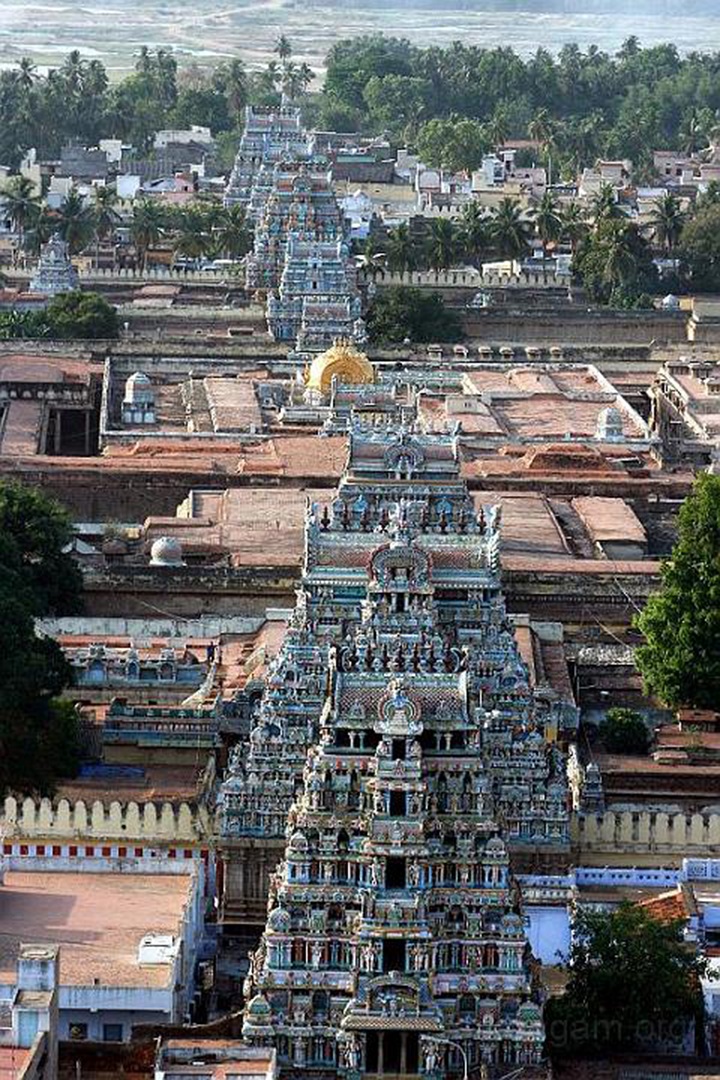
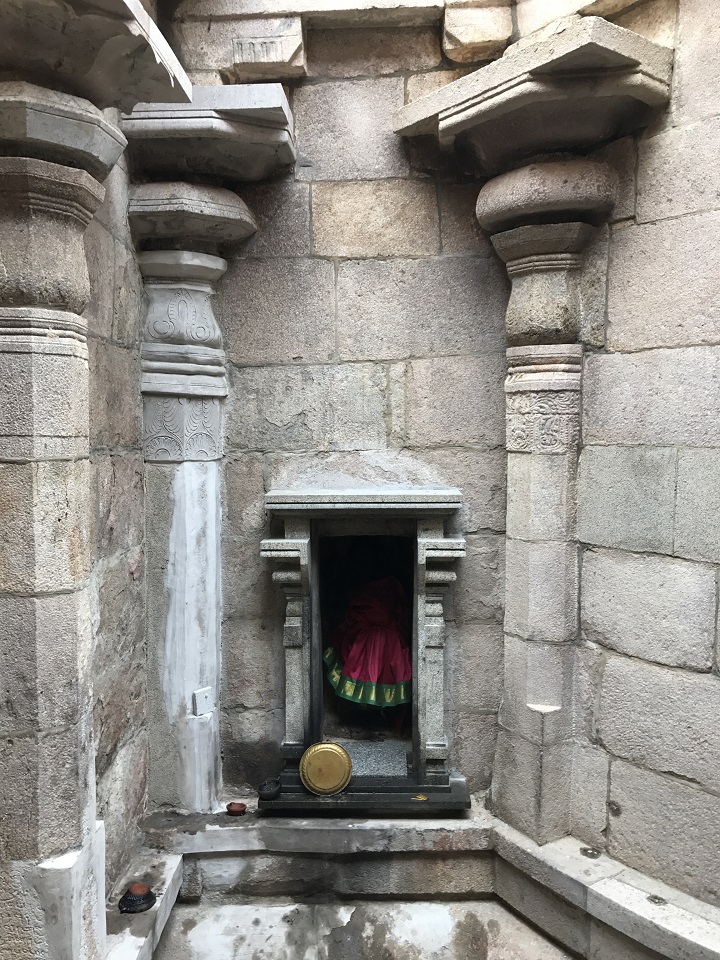
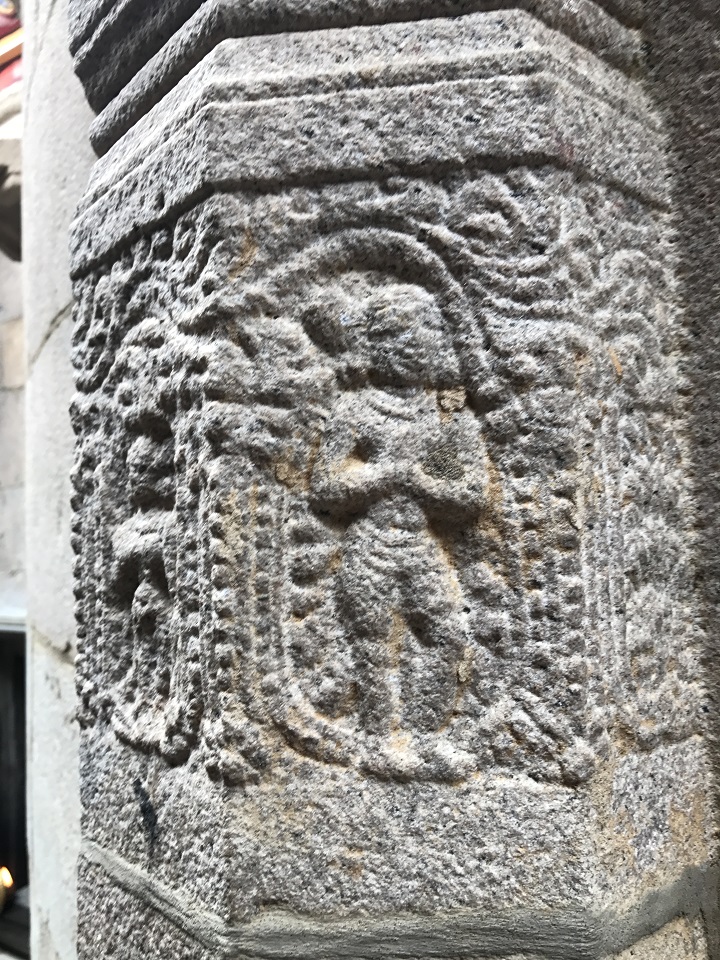
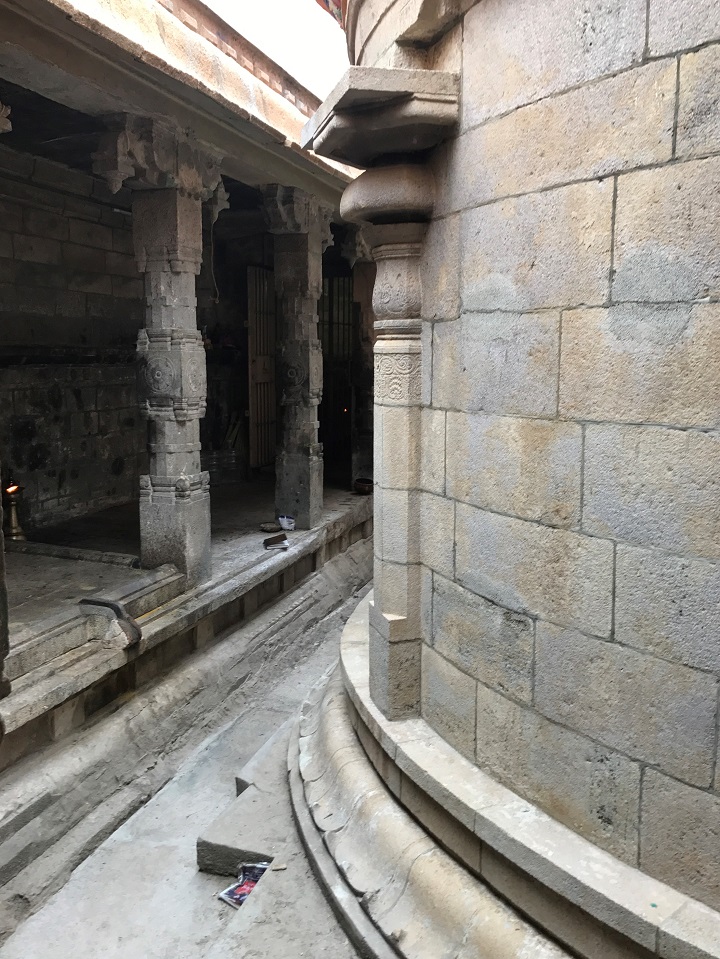
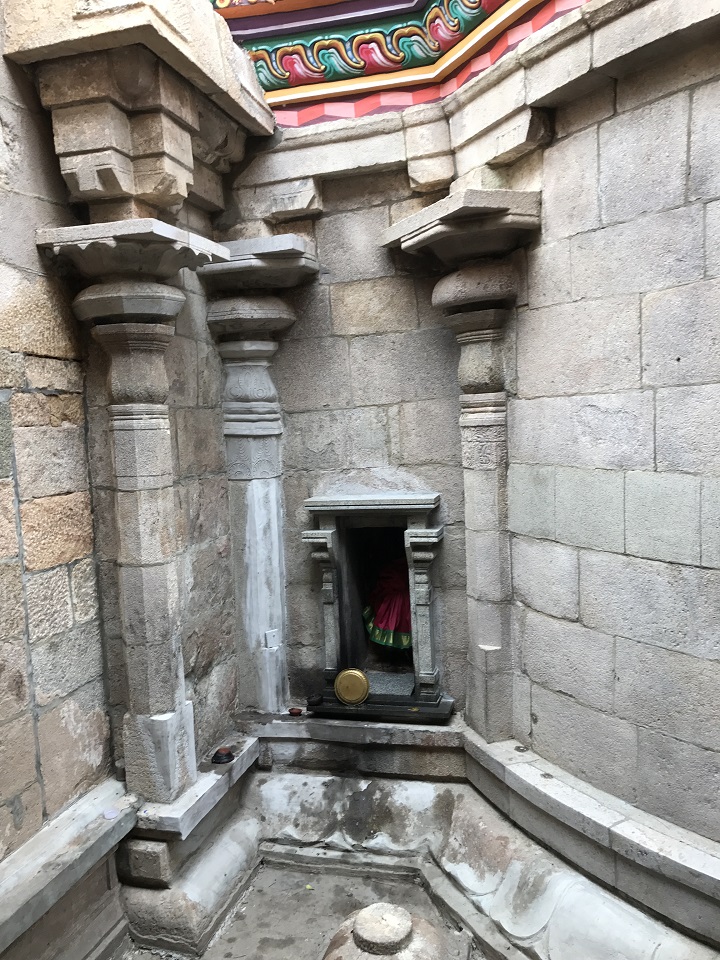 RaṅgavimānaPlan
RaṅgavimānaPlan  Ground plan for the Sanctum and Mukha Mandapa Vimāna āditaḷa rises over an adhishthana, which could not be classified architecturally with certainty. It includes a upāna, tall Padma jagatī, relatively small kantha and a projecting pattika. (such type of adhishthana is also seen at the gajaprishta vimana of Baktavatsala temple at Thirukalukkundram) Cylindrical āditaḷa wall that rise above the adhishthana is supported by eight pilasters, distributed evenly over the circumference of the circular wall. Entrance to the main sanctum is provided in-between the two pilasters on the south side; ardhamaṇḍapa walls extended to the south of the vimāna, immediately after these south side pilasters. Walls are plain without any dēvakoshtha recess. Pilasters studded along the āditaḷa wall include a square pādā and above that raises the viṣhṇukāntha shaft which is ornamented with the capital components of mālā, śthāna, kalasa, tādi, kumbha, pālika, phalaka and vīrakantha.The sthana is decorated with creepers or geometrical patterns whereas the mala is decorated with beaded garlands with flowers or miniatures inside. Inside the beaded mala three-to-four flowers gathered as festoons are commonly seen. Miniatures are seen in four of the pilasters mostly of female in dancing postures. The dancers in the usual half seated posture with their legs in swastika and their one hand elegantly stretched on their side while their other hand is showing a mudra. The dancers are decked with all usual ornaments, short attire draping their lower body and their locks gathered as heavy knot on their side head. Breast band is absent for all. Inside in one of the garland a male with a club is seen, the club is held on his left side, in a leaning posture he is resting his left hand on the club and his right hand is folded up. As like, in another pilaster a male is seen in anjali hasta. In the sthana also in one of the pilaster a gana is seen, in another pilaster yazhi is seen. The potikas that rest above the pilasters are vettu in type and taranga ornamentations are shown on its faces. Potikas extend its arms on either side supporting the praśtara components, which include uttira and vājana. All other components of praśtara and the entire superstructure is in stucco, painted and reconstructed in recent times disturbing the original composition. The valabhi is decorated with padma series, heavy kudu arches adorn the kapota, in addition, chandramandalas are shown in the edges. The tala ends with the bhumidesa. The griva and the sikhara, rests on the vedika that lie little inside above the bhumidesa. The griva is adorned with rudrakantha pilasters arranged in sequence to the pilasters of the aditala. The pilasters possess all the usual capital components and the potikas above the pilasters are vettu-taranga as like the potikas of the aditala. The pilasters bear the usual prastara elements in which the valabhi is decorated with hamsa series. Above the valabhi, the maddalas raise up to bear the edges of the sikhara. The body of the sikhara is gold plated, four stupis are shown in the finial. Few fragment inscriptions are seen in the basement, pilasters of mukha mandapa both on the eastern and western side, which can be viewed only inside the Dharmavarman thiruchurru. One of the fragment carry the soubriquet Korajakesari.
Ground plan for the Sanctum and Mukha Mandapa Vimāna āditaḷa rises over an adhishthana, which could not be classified architecturally with certainty. It includes a upāna, tall Padma jagatī, relatively small kantha and a projecting pattika. (such type of adhishthana is also seen at the gajaprishta vimana of Baktavatsala temple at Thirukalukkundram) Cylindrical āditaḷa wall that rise above the adhishthana is supported by eight pilasters, distributed evenly over the circumference of the circular wall. Entrance to the main sanctum is provided in-between the two pilasters on the south side; ardhamaṇḍapa walls extended to the south of the vimāna, immediately after these south side pilasters. Walls are plain without any dēvakoshtha recess. Pilasters studded along the āditaḷa wall include a square pādā and above that raises the viṣhṇukāntha shaft which is ornamented with the capital components of mālā, śthāna, kalasa, tādi, kumbha, pālika, phalaka and vīrakantha.The sthana is decorated with creepers or geometrical patterns whereas the mala is decorated with beaded garlands with flowers or miniatures inside. Inside the beaded mala three-to-four flowers gathered as festoons are commonly seen. Miniatures are seen in four of the pilasters mostly of female in dancing postures. The dancers in the usual half seated posture with their legs in swastika and their one hand elegantly stretched on their side while their other hand is showing a mudra. The dancers are decked with all usual ornaments, short attire draping their lower body and their locks gathered as heavy knot on their side head. Breast band is absent for all. Inside in one of the garland a male with a club is seen, the club is held on his left side, in a leaning posture he is resting his left hand on the club and his right hand is folded up. As like, in another pilaster a male is seen in anjali hasta. In the sthana also in one of the pilaster a gana is seen, in another pilaster yazhi is seen. The potikas that rest above the pilasters are vettu in type and taranga ornamentations are shown on its faces. Potikas extend its arms on either side supporting the praśtara components, which include uttira and vājana. All other components of praśtara and the entire superstructure is in stucco, painted and reconstructed in recent times disturbing the original composition. The valabhi is decorated with padma series, heavy kudu arches adorn the kapota, in addition, chandramandalas are shown in the edges. The tala ends with the bhumidesa. The griva and the sikhara, rests on the vedika that lie little inside above the bhumidesa. The griva is adorned with rudrakantha pilasters arranged in sequence to the pilasters of the aditala. The pilasters possess all the usual capital components and the potikas above the pilasters are vettu-taranga as like the potikas of the aditala. The pilasters bear the usual prastara elements in which the valabhi is decorated with hamsa series. Above the valabhi, the maddalas raise up to bear the edges of the sikhara. The body of the sikhara is gold plated, four stupis are shown in the finial. Few fragment inscriptions are seen in the basement, pilasters of mukha mandapa both on the eastern and western side, which can be viewed only inside the Dharmavarman thiruchurru. One of the fragment carry the soubriquet Korajakesari. 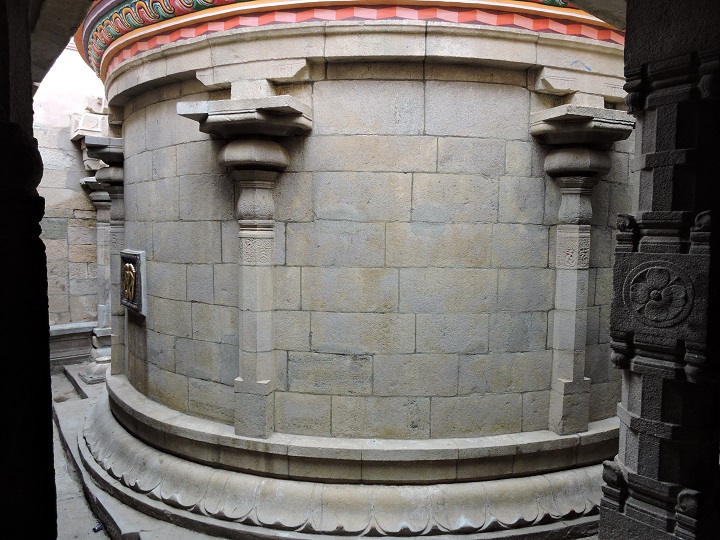 Vesara Vimana of Sriranganathaswami Shrine Ardhamaṇḍapa On the southern side in between two pilasters of the vimana, the ardhamandapa extends to a length of 4'6”towards south. On both the sides, from the potikas that rest above the pilasters, one of the arm turns towards south to the bear the prastara of the ardhamandapa. The ardhamandapa has a pair of pilasters each one on the southern end carrying the same features of the pilasters of the vimana, but partially met with refurbishment. The potikas of the ardha-mandapa are also vettu-taranga type and bear the uttira, followed by vajana. The other prastara components above the vajana are recent constructions. Niches are provided on the eastern and western sides of the ardhamandapa, adorned by Durga and Gaṇapati respectively. The ardha-mandapa is also crowned by sikhara, but with sala sikhara. The griva of the vimana continuously run over the ardhamandapa, carrying the same features; a pair of pilasters one on each side adorn the griva in sequence to the pilasters of the ardha mandapa and possess the same features of the pilasters of the griva of vimana. The sala sikhara extend adjoining the Vesara sikhara of the vimana, hence forming a half sala sikhara. At some instance it looks like a large mahanasika adorning the southern side of the Vesara sikhara. The sikhara of the ardha mandapa is also gold plated and four stupi is shown in the apex. THE DHARMAVARMAN THIRUCHURRU The thiruchurru that immediately encompass the vimana is known as Dharmavarman Thiruchurru. It has a single row of pillars raised on a upapitha with the components of upoupana, upana, padma, kantha with pada flanked by kampa and peruvajana and upari kampa. The pillars are ornamented as three squares and indrakattu in between intersected by padmakattu at their meeting points. The indrakattu is further ornamented with a Vishnu kattu band in the middle. While the lower and upper squares are plain, the middle square is adorned with flower medallions on all the sides. Besides, the lower square is adorned with nagabandha at the corners. The potikas are madalai and nanudalthat bear the usual prastara elements. The roof of the thiruchurru is covered with slabs that extend in the inner side as flexed over hanging kapota. The roof of the thiruchurru is fully adorned with paintings of Vijayanagar period. The opening and exit to the thiruchurru is on the south which is kept closed. The pillars and the potikas of the thiruchurru denote its periodas Vijayanagar era. THE GAYATHRI MANDAPA The mandapa next to the ardhamandapa is known as Gayathri mandapa, a pillared hall with plain rudrakantha pillars, the potikas that rest above the pillars are madalai and nanudal with a well-developed bud at the end of the spout. The potikas bear the usual prastara components and the mandapa is covered with stone slabs. Inscription of UttamaChola (SII Vol.XXIV, 12) is seen in one of the rudrakantha pillar in the mandapa. Besides, the entrance to the mandapa has an ornamental door frame with the inscriptions of ParantakaChola I (SII Vol.XXIV, 7, 8, 10) and Gandaraditya or SundaraChola (SII Vol.XXIV, 11). Period of the structures Literary references indicate that the temple was in existence before 7th Century CE, as observed earlier. However, the available architectural and epigraphic remnants are that of Chōḷa period, indicating that the original brick structure should have been rebuilt sometime around 11th Century CE. A highly ornate door frame containing earliest epigraphic evidence within the temple premises, an inscription of Rājakēsarivarman, who can be identified with ĀdityaChōḷaI, has been dislocated from the central shrine and is found in the temple cow shed. The quality of sculptures in this door jamb indicate that it should have been a part of the central shrine; it is likely that it was originally located in front entrance of the ardhamaṇḍapa abutting the central shrine, in a prior brick composition. When renovations were undertaken in the middle Chōḷa period in 11th Century CE, the brick vimana and ardhamaṇḍapa were rebuilt out of stone (probably retaining the dimensions and composition of the original structure), the door jamb got dislocated. This inference gets further support by the fact that the second doorjamb, whose quality and sculptures are comparable to that of the first, containing another early inscriptions (that of ParāntakaChōḷa - I) is still found in the entrance of gāyatri maṇḍapa. Thus, the Raṅgavimāna itself can be assigned to 11th Century CE while the two door jambs belong to the period of Early Cholas, especially Parantaka I. Acknowledgements The authors wish to express their thanks to Mr. P.Jayaraman, Executive officer and Joint commissioner, SrīRaṅganāthaswāmi temple, Srīraṅgam, for permitting us to study the temple architecture in detail. Thanks to Mr. R.Ramakrishnan, Deputy Commissioner of Police, for his constant encouragement and support to our research activities. Our thanks to conveners of TamilNadu History Congress for publishing this paper. Bibliography • Annual Report on Epigraphy(1893), Archaeological Survey of India,New Delhi. • Charles Dillard Collins, The Iconology and Ritual of Siva at Elephanta, State University of New York Press, New York (1988). • ManmathaNathDutt, The Ramayana of Valmiki(English translation in six volumes), ManmathanathDutt, Calcutta, 1897. • Michael W.Miester, et al.,Encyclopiedia of Indian Temple Architecture: Vol-I, Part-I, American Institute of Indian Studies, New Delhi, 1983. • Nalini, M. and Kalaikkovan, R., Madurai MavattaKudaivaraigal (Tamil), Dr.M.Rajamanikkanar Institute of Historic Research, Tiruchirappalli, 2007. • Rajendran, R. et al. (ed.), Kalithogai, Project Madurai, 2005. • Rea, Alexander.,Pallava Architecture (Facsimile of 1909 ed.), Asian Educational Services, New Delhi (1995).
Vesara Vimana of Sriranganathaswami Shrine Ardhamaṇḍapa On the southern side in between two pilasters of the vimana, the ardhamandapa extends to a length of 4'6”towards south. On both the sides, from the potikas that rest above the pilasters, one of the arm turns towards south to the bear the prastara of the ardhamandapa. The ardhamandapa has a pair of pilasters each one on the southern end carrying the same features of the pilasters of the vimana, but partially met with refurbishment. The potikas of the ardha-mandapa are also vettu-taranga type and bear the uttira, followed by vajana. The other prastara components above the vajana are recent constructions. Niches are provided on the eastern and western sides of the ardhamandapa, adorned by Durga and Gaṇapati respectively. The ardha-mandapa is also crowned by sikhara, but with sala sikhara. The griva of the vimana continuously run over the ardhamandapa, carrying the same features; a pair of pilasters one on each side adorn the griva in sequence to the pilasters of the ardha mandapa and possess the same features of the pilasters of the griva of vimana. The sala sikhara extend adjoining the Vesara sikhara of the vimana, hence forming a half sala sikhara. At some instance it looks like a large mahanasika adorning the southern side of the Vesara sikhara. The sikhara of the ardha mandapa is also gold plated and four stupi is shown in the apex. THE DHARMAVARMAN THIRUCHURRU The thiruchurru that immediately encompass the vimana is known as Dharmavarman Thiruchurru. It has a single row of pillars raised on a upapitha with the components of upoupana, upana, padma, kantha with pada flanked by kampa and peruvajana and upari kampa. The pillars are ornamented as three squares and indrakattu in between intersected by padmakattu at their meeting points. The indrakattu is further ornamented with a Vishnu kattu band in the middle. While the lower and upper squares are plain, the middle square is adorned with flower medallions on all the sides. Besides, the lower square is adorned with nagabandha at the corners. The potikas are madalai and nanudalthat bear the usual prastara elements. The roof of the thiruchurru is covered with slabs that extend in the inner side as flexed over hanging kapota. The roof of the thiruchurru is fully adorned with paintings of Vijayanagar period. The opening and exit to the thiruchurru is on the south which is kept closed. The pillars and the potikas of the thiruchurru denote its periodas Vijayanagar era. THE GAYATHRI MANDAPA The mandapa next to the ardhamandapa is known as Gayathri mandapa, a pillared hall with plain rudrakantha pillars, the potikas that rest above the pillars are madalai and nanudal with a well-developed bud at the end of the spout. The potikas bear the usual prastara components and the mandapa is covered with stone slabs. Inscription of UttamaChola (SII Vol.XXIV, 12) is seen in one of the rudrakantha pillar in the mandapa. Besides, the entrance to the mandapa has an ornamental door frame with the inscriptions of ParantakaChola I (SII Vol.XXIV, 7, 8, 10) and Gandaraditya or SundaraChola (SII Vol.XXIV, 11). Period of the structures Literary references indicate that the temple was in existence before 7th Century CE, as observed earlier. However, the available architectural and epigraphic remnants are that of Chōḷa period, indicating that the original brick structure should have been rebuilt sometime around 11th Century CE. A highly ornate door frame containing earliest epigraphic evidence within the temple premises, an inscription of Rājakēsarivarman, who can be identified with ĀdityaChōḷaI, has been dislocated from the central shrine and is found in the temple cow shed. The quality of sculptures in this door jamb indicate that it should have been a part of the central shrine; it is likely that it was originally located in front entrance of the ardhamaṇḍapa abutting the central shrine, in a prior brick composition. When renovations were undertaken in the middle Chōḷa period in 11th Century CE, the brick vimana and ardhamaṇḍapa were rebuilt out of stone (probably retaining the dimensions and composition of the original structure), the door jamb got dislocated. This inference gets further support by the fact that the second doorjamb, whose quality and sculptures are comparable to that of the first, containing another early inscriptions (that of ParāntakaChōḷa - I) is still found in the entrance of gāyatri maṇḍapa. Thus, the Raṅgavimāna itself can be assigned to 11th Century CE while the two door jambs belong to the period of Early Cholas, especially Parantaka I. Acknowledgements The authors wish to express their thanks to Mr. P.Jayaraman, Executive officer and Joint commissioner, SrīRaṅganāthaswāmi temple, Srīraṅgam, for permitting us to study the temple architecture in detail. Thanks to Mr. R.Ramakrishnan, Deputy Commissioner of Police, for his constant encouragement and support to our research activities. Our thanks to conveners of TamilNadu History Congress for publishing this paper. Bibliography • Annual Report on Epigraphy(1893), Archaeological Survey of India,New Delhi. • Charles Dillard Collins, The Iconology and Ritual of Siva at Elephanta, State University of New York Press, New York (1988). • ManmathaNathDutt, The Ramayana of Valmiki(English translation in six volumes), ManmathanathDutt, Calcutta, 1897. • Michael W.Miester, et al.,Encyclopiedia of Indian Temple Architecture: Vol-I, Part-I, American Institute of Indian Studies, New Delhi, 1983. • Nalini, M. and Kalaikkovan, R., Madurai MavattaKudaivaraigal (Tamil), Dr.M.Rajamanikkanar Institute of Historic Research, Tiruchirappalli, 2007. • Rajendran, R. et al. (ed.), Kalithogai, Project Madurai, 2005. • Rea, Alexander.,Pallava Architecture (Facsimile of 1909 ed.), Asian Educational Services, New Delhi (1995).












